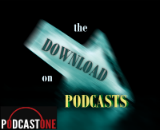The Download on Podcasts is a weekly feature sponsored by PodcastOne.
The second season of Serial has launched, before the first season’s hype has expired. The hype is deserving, if monotonous. Serial is by many estimations the spark which ignited a reputed podcast resurgence. Norman Pattiz, founder of PodcastOne (which sponsors this column), told an audience at RAIN Summit West, “Podcasting owes Serial a debt of gratitude that can never be repaid.”
In the time since Serial broke iTunes download records, something resembling a podcast industry has emerged. Awareness of podcasting has rocketed, and the listening audience has grown. Edison Research reported early this year that 46-million Americans listen to podcasts every month.
Money has flowed into the space, both from advertisers and institutional investors. At RAIN News we hear from off-the-record sources that advertising CPMs can range upward close to $100. Investor money has stormed into the space — Hubbard Radio bought 30% of PodcastOne, and legacy media giant Scripps acquired Midroll Media outright.
Serial is making a play for new audience with the second season, which streams in a unique presentation on the market-leading Internet radio platform, Pandora. That, and Live2365’s partnership with Blubrry for Podcast2Radio are attempts to wrench podcasting away from its historical download model and install it in the streaming universe. (Deezer’s acquisition of Stitcher has the same goal.)
So, as Serial starts up again, the natural question arises: What’s next?
Nicholas Quah, head of audience development at Slate-owned Panoply and author of the HotPod newsletter, looks toward 2016 with some cogent thoughts. “The future of podcasting is not guaranteed,” he says in a predictive essay for NiemanLab. “2016 is going to be the year when the professionalizing podcast industry finds out if it’s able to earn its place in the media big leagues.”
Growing audience, sustaining high CPMs, and building relationships with a range of distribution modes are the keys for Quah. CPM-based monetization and alternate distribution could be linked in a challenging way. Podcast publishing platforms are increasingly looking to adapt modern ad-tech solutions for podcasting, which is historically a hand-sold category that specializes in host-read commercials. All that historical touching is what gives podcasting its high trust value throughout the chain, but also inhibits fast scaling and earning capability to many semi-pro shows.
That said, secular trends shine positive light on the future, especially the stampede of consumers to mobile listening, where podcasting can thrive with its relatively low bandwidth. Increasingly connected cars can also foster engagement in radio’s traditional stomping ground — drive times.
Another favorable trend is the appropriation of podcasting by global media brands and celebrities. Podcasting is becoming a checklist item for publishers and personalities. While that could lead to a certain degree of uninspired programming, it also drives audience growth from many directions.
One question for 2016 and beyond is whether podcasting is fast becoming too institutionalized and professionalized, leaving its blog-inspired roots in the ground as the category soars. If it plays out like that, podcasting will resonate with the history of blogging. And, truth be told, all media categories that reach the mainstream develop a concentration of fame, engagement, and money at the top, fed by institutional leverage over large audience groups. Musicians know all about that, and in a couple of years podcasters might be singing — er, speaking — a similar tune.

